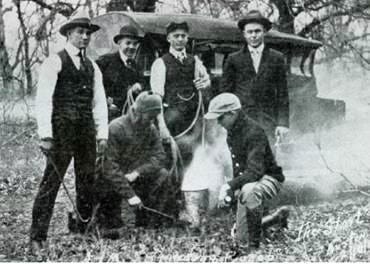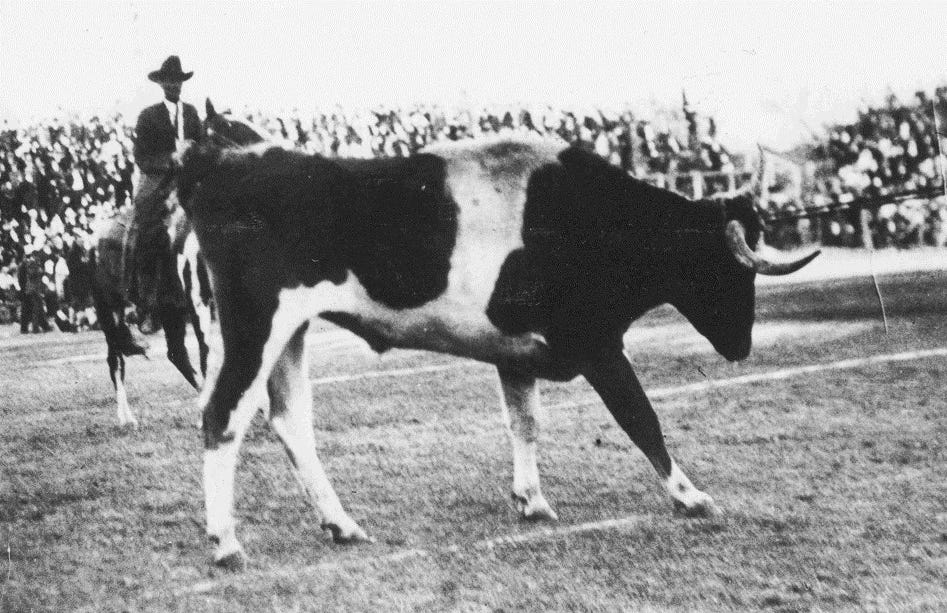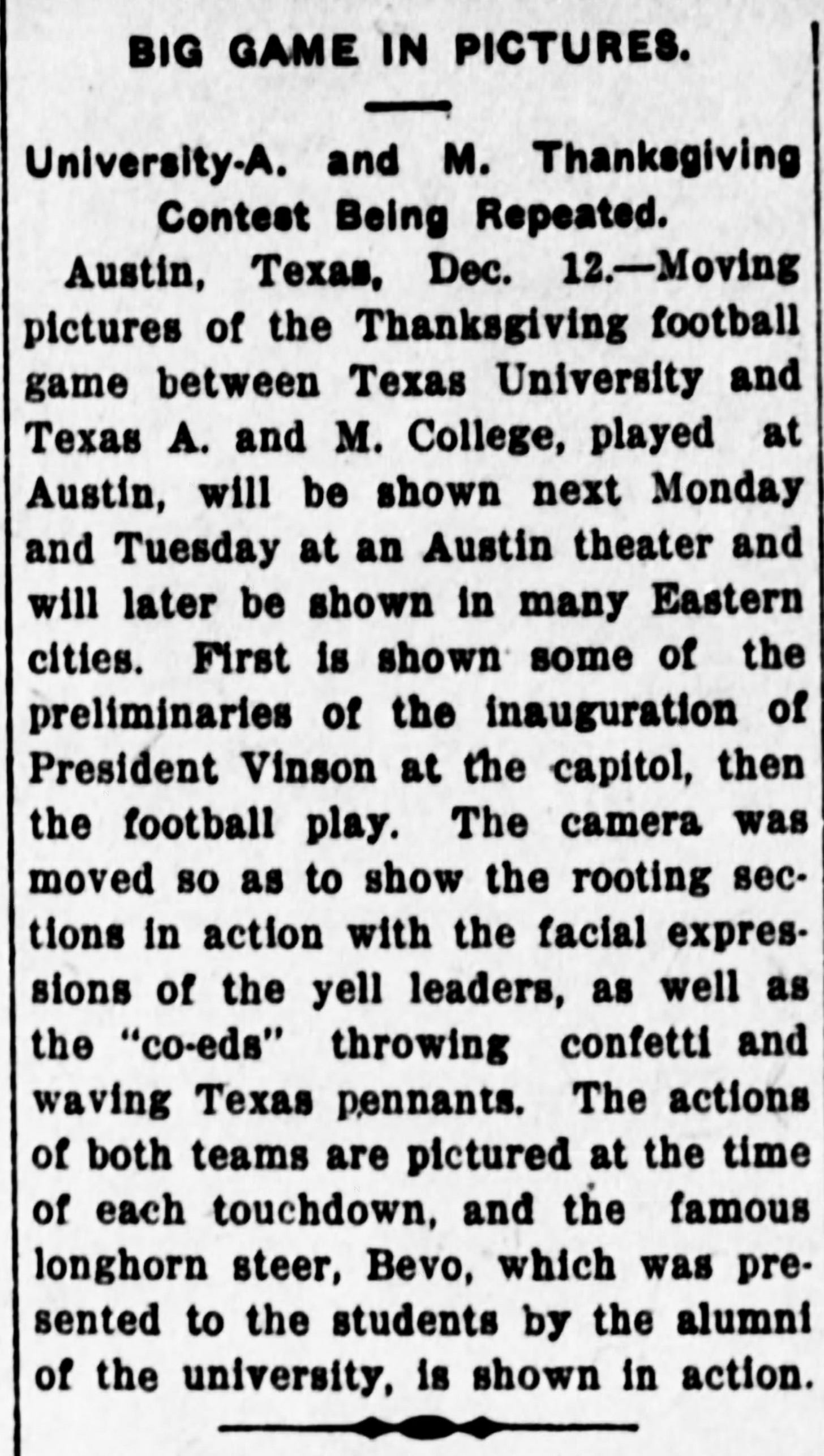Bevo and the Myth of 13–0

His name is Bevo. Long may he reign!
Ben Dyer
It was a chilly February morning in 1917, a Sunday, when six pranksters from the Agricultural and Mechanical Texas College broke into a South Austin stockyard. In the 3:00 am darkness, every breath created a fine mist. They carried fire-making materials and a road brand—a bit of carved steel used for branding cattle freehand. Once inside, they built a fire and shoved the iron into the heat’s heart and warmed themselves while the metal grew hot. They then roped a longhorn steer that a few months earlier had been introduced as the new mascot for their arch rivals: The University of Texas. When the branding iron glowed red, they ran it over the longhorn’s tough hide, scarring the 1915 football score between the two schools into the animal’s side. The contest that year was won by the A & M Aggies, 13–0.

For nearly 110 years now, the Aggies have bragged that UT’s longhorn mascot, “Bevo,” derived his name from that branding. To hear them tell the tale, in an effort to erase the embarrassment of that loss, UT students converted the “13” into a “B,” the dash into an “E,” and inserted a “V” before the “0.” And now that it’s finally fall, you can be as sure as I’m an 1836 percent purebred, open-range Texan that I’ll be reminded from my Aggie friends as to the naming origin of my alma mater’s mascot.
Bless their little Aggie hearts. If only their myth were true.
The last day of November 1916 was Thanksgiving Day and the University of Texas was celebrating not only Thanksgiving but also the inauguration of a new president: Robert Vinson. The ceremony was held in the House of Representatives in the Capitol. Afterward, faculty, staff, and students enjoyed a box lunch on the Forty Acres, the original tract of land for the University. The annual football game with A & M followed. Fifteen thousand fans packed the wooden bleachers of Clark Field, the University’s first athletic field, and cheered on the defensive battle that ended the first half in a tie: 7–7.

During halftime two cowboys dragged a half-starved and half-crazed longhorn steer onto the field. Stephen Pinckney, an alumnus of UT (LL.B. 1911), had long wanted to present a longhorn to the student body as the University’s mascot—a gift from the Texas Exes. He got his chance while working for the United States Attorney General’s office in West Texas, assisting in the apprehension of cattle rustlers. On a raid near Laredo, Pinckney spotted an orange-colored longhorn. He petitioned and received $124.00 from 124 alumni, each contributing a dollar apiece. With his own dollar in the pot, Pinckney purchased and transported the longhorn to Austin. On the field, fellow alumnus Tom Buffington (LL.B. 1892) addressed the student section:
I have been requested to present to the University of Texas a mascot or protecting spirit that now and in future years will bring good luck to the institution and its teaching. Behold him! The Longhorn of Texas, emblematic as he stands of the fighting spirit of progress. As the great longhorn was free to roam the wilderness of Texas, so must the University be free to roam the world of thought, unhampered and unafraid.
The student body enthusiastically adopted their new mascot. But the longhorn was too wild to remain on the sidelines for the second half of the game, so was taken to the Seawright stockyards in South Austin, where he was fed and watered. A photographer tagged along, taking one flash photograph before the steer charged camera and cameraman, who scurried out of the corral just before being trampled or gored.

Back at Clark Field, the Texas football team scored two touchdowns on two punt returns to win the game 21–7.
News of the new University president, of the football game, and of the new mascot spread quickly. A silent film was made of the day’s events, including Vinson’s inauguration, the football game, and the presentation of the longhorn steer. Articles about the film appeared statewide on December 12, including in the Austin Statesman and the Bryan-College Station Eagle, which referred to “the famous longhorn steer, Bevo.”

That same month, in the December 1916 edition of the alumni magazine, the Texas Exes Alcalde, editor Ben Dyer (BA 1919) published a full accounting of the weekend, including the gift of the longhorn. He wrote: “His name is Bevo. Long may he reign!”
So, you see, the joke is on the Aggies—yet again.
“Bevo” is a play on word beeve, which is the plural of beef, as well as cowboy slang for a cow or steer destined for slaughter. The letter “o” was most likely added because of a popular comic strip by Gus Mager in the 1900s and 1910s which featured monkeys whose characters’ names always ended in the letter “o.” It was a common practice among friends to give each other nicknames ending with the letter “o.”
Though no one knows for sure who named the University of Texas mascot, Pinckey is the top suspect, who probably named the longhorn Bevo sometime around Thanksgiving 1916.



Pure heresy. 😂
I’m not persuaded. Plus, Bevo is not a play on words; it was a popular soft drink brand at the time.